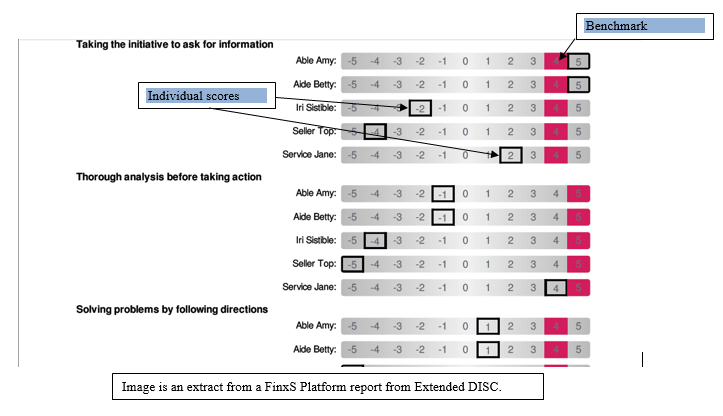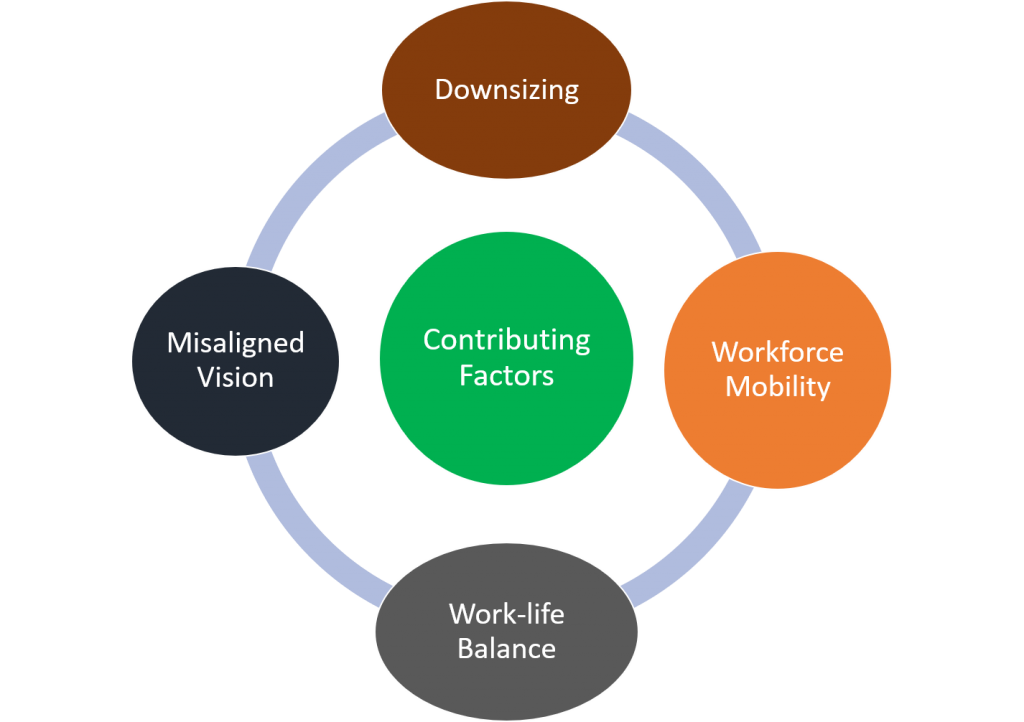Employee Engagement and Productivity
How “Square Pegs” Fuel High Turnover and Low Engagement
Sentenced to use your less favoured hand 40 hours per week!
Required to collaborate with colleagues from an alien culture in an unknown language.
For good measure, you only perform tasks that you find frustrating.

Unfortunately, those scenarios reflect how many employees feel about their jobs. They dread coming to work and suffer through their time there as they watch the clock wind down to give them relief.
Naturally, they strive to find a way out which is reflected in high staff turnover. Some even prefer to sit it out at home until they can find something more suitable, so as to preserve their peace of mind.
Recent experiences with organizations have brought to the fore once again the impact of square pegs in round holes and the critical importance of ROLE FIT.
In many organizations, there is a tendency to define the “technical” requirements for jobs – professional skills, training/education, work experience, etc. However, they fail to pay sufficient attention to the behavioural requirements of the role to be performed.
Many failures on the job are not based on a lack of professional skills but on deficiencies in demonstrating the behavioural competences that are needed for effectiveness in the role. Things like the capacity to relate effectively to others. Or achieving results with and through people. Giving and receiving instructions. Handling feedback. Being a team player. Effective communication.
A seminal Harvard study attributed 85% of success to Inter-personal skills and only 15% to Technical competence. That means that a highly skilled auditor might lose clients for her firm because of her poor people skills.
I constantly hear tales of woes about leaders with failing inter-personal skills grades.
Team members withdraw and do just enough to get through performance appraisals in order to keep their jobs. Engagement and enthusiasm go out the door with the failure to empower and inspire. This might be taking place closer to you than you realize or allow yourself to accept!
SOLUTION
We like to address problems so here is a strategy that we have used to address the challenges arising from the square peg/round hole issue.

We suggest the implemention of a 5-step Talent Acquisition strategy:
- Develop a competency-based “Ideal Behavioural Profile” for each role using Extended DISC® behavioural assessments on the revolutionary FinxS® Platform.
- Conduct Personal Behavioural DNA Analyses of applicants incorporating degrees of fit in percentage terms against the “Ideal Behavioural Profile” for the role.
- Providing an Interview Map to guide targeted interviewing of the candidates.
- Creating a Multi-person Report that provides line-by-line comparative analysis among the candidates and against the Ideal Behavioural Profile list of competences.
- Appending a brief Open-ended Questionnaire to the assessment that requires candidates to provide historical evidence of their demonstration of select core competences. The questions apply leading-edge Behavioural Interviewing Techniques to capture information on issues such as Integrity, Commitment, Courage and Goal-focus. The responses are included in the comprehensive assessment package along with the psychometric and competency-based components.
The Ideal Behavioural Profile is an effective and powerful tool that is best developed by collecting and combining the input of key players in the organization using a selection of behavioural competencies from the revolutionary FinxS® Competency library. Alternatively, Extended DISC®/FinxS® experts or trained practitioners create the Ideal Behavioural Profile based on the Job Descriptions that are provided.
Boost Employee Engagement
Transform the employee experience from recruitment and on-boarding through to talent development. Enhance employee engagement and productivity with an insights-driven approach.
Stunning findings from the Deloitte _ 2015 Global Human Capital Trends Survey
Low Employee Engagement
Culture and Engagement identified as the most important issue companies face.
87% Culture and Engagement is one of their top challenges.
50% The Culture And Engagement problem is “very important”.
Studies consistently point to low employee engagement and motivation.
“Organizations that create a culture defined by meaningful work, deep employee engagement, job and organizational fit, and strong leadership are outperforming their peers and will likely beat their competition in attracting top talent.”

One of the legacies of the raft of downsizing that spread like a virus during the 90’s is the global phenomenon of low employee engagement. American corporations announced 615,186 layoffs in 1993 alone and over eighty-five percent of Fortune 1000 companies reduced their white collar workforce between 1987 and 1991 (Dougherty & Bowman).
Large numbers of the current workforce experienced financial ruin then or watched their co-workers, neighbours, family and friends go through difficult times. Those images are etched in their memory and restrains the unbridled commitment and enthusiasm that is so starkly absent from today’s work environment.
If you are charged with getting high performance from a group comprised of such individuals, what can you do?
The key missing ingredient is COMMITMENT.
Subconsciously, employees have a sense of dread of being blindsided like the thousands who had strong feelings of security and attachment to their jobs.
The double whammy of downsizing is that it was invariably linked to the first port of call of cost cutting – the TRAINING BUDGET. Many thrown out of work were ill-equipped to cope as they had not benefited from a significant upgrade in their skills on the job.
This presents a challenge and an opportunity. I suggest that at no time in history has such a high percentage of the workforce been as committed to taking a personal interest in their personal development and in taking concrete steps to upgrade their competence.
Employers could grasp this opportunity and remove some of the impact of the downsizing hangover.
One practical step would be using Extended DISC® user-friendly surveys to evaluate employee readiness to sign up for training and the areas that will support the future-readiness of the organization.

THE IMPACT OF CULTURE
Leaders oftentimes underestimate the importance of culture when instituting change. That can be a costly mistake as the change initiative is derailed.
Leaders who want to institute measures that impact the usual way of operating must take care to evaluate the nature and the strength of the opposing forces as well as the cultural environment.
For example, are trends outside the organization aligned with the actions that they are taking?
Can they sell their strategy on the basis that similar actions are being taken by trendsetting organizations?
Alternatively, will external evidence highlight the fact that the planned policies are archaic and counterproductive?
Leaders must evaluate their strategy in the context of the cultural environment.
The new FinxS® Culture Reports provide insights that is invaluable and not available from any other source.
Boost Employee Engagement
Transform the employee experience from recruitment and on-boarding through to talent development. Enhance employee engagement and productivity with an insights-driven approach.
Employer And Employee Responsibility
Righting the critical COMMITMENT challenge requires that employers increase their stake in the game.
Bemoaning the lack of motivation and bringing in motivational speakers for half-day sessions because you can’t afford to take off a full day for training is not going to cut it. Reversal will start when employers demonstrate concrete commitment – at least to their mission critical staff.
Since personal development appears to be near the top of the list of what employees treasure at this time developing and implementing meaningful Learning & Development and Coaching & Mentoring programmes is a no-brainer, direct pathway to increased employee engagement.
But, what if you are a team leader not gifted with the opportunity to create and fund structured developmental programmes? Is there something that you can do in your small corner?
Step 1: Establish yourself as team advocate. Leave no doubt through concrete example that you are willing to defend the best interest of the team at all times. Team goals should be aligned to organizational goals so what is truly best for the team should be good for the organization.
Step 2: Make sure to keep open the channel for the upward flow of communication. Too many team leaders are mere speaker boxes for management. Provide substantive evidence that you give voice to team concerns at the upper levels to ensure credibility.
Step 3: As team leader you must have some qualities that have set you apart from your colleagues. What if you took on the task of mentoring and coaching your team members? You can share what you know, your philosophy, your vision etc. You can give them opportunities for acquiring new skills.
If you buy-in to this you can add interesting dimensions. Go where your imagination takes you.
Demonstrate in real terms that you care about your team and you may be surprised to find that they become an oasis in the midst of a desert of disengagement.
WHAT IS IN IT FOR YOU THE TEAM LEADER? Rocket movement up the ladder. Effective team leaders are like hidden treasure.
Help Team Leaders drive employee engagement by providing them with Extended DISC® Team Diagnostics.
